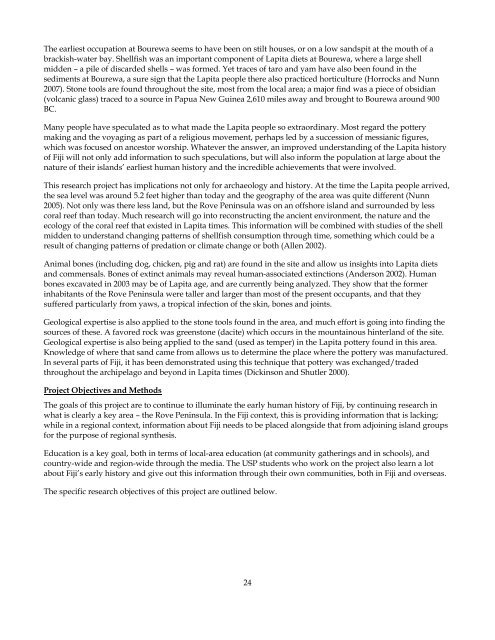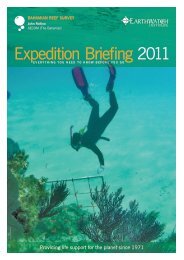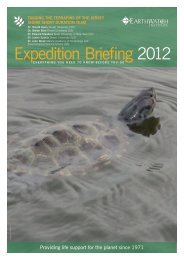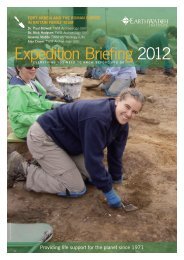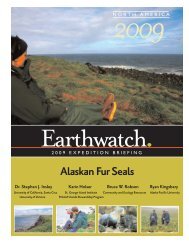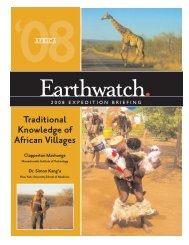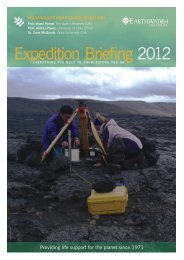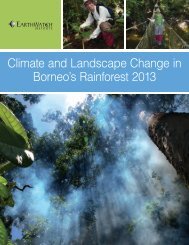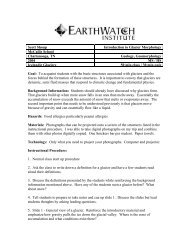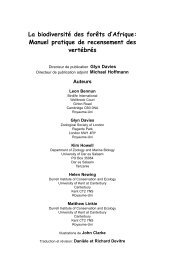Fiji's Ancient Seafarers Dr. Patrick D. Nunn - Earthwatch Institute
Fiji's Ancient Seafarers Dr. Patrick D. Nunn - Earthwatch Institute
Fiji's Ancient Seafarers Dr. Patrick D. Nunn - Earthwatch Institute
Create successful ePaper yourself
Turn your PDF publications into a flip-book with our unique Google optimized e-Paper software.
The earliest occupation at Bourewa seems to have been on stilt houses, or on a low sandspit at the mouth of a<br />
brackish-water bay. Shellfish was an important component of Lapita diets at Bourewa, where a large shell<br />
midden – a pile of discarded shells – was formed. Yet traces of taro and yam have also been found in the<br />
sediments at Bourewa, a sure sign that the Lapita people there also practiced horticulture (Horrocks and <strong>Nunn</strong><br />
2007). Stone tools are found throughout the site, most from the local area; a major find was a piece of obsidian<br />
(volcanic glass) traced to a source in Papua New Guinea 2,610 miles away and brought to Bourewa around 900<br />
BC.<br />
Many people have speculated as to what made the Lapita people so extraordinary. Most regard the pottery<br />
making and the voyaging as part of a religious movement, perhaps led by a succession of messianic figures,<br />
which was focused on ancestor worship. Whatever the answer, an improved understanding of the Lapita history<br />
of Fiji will not only add information to such speculations, but will also inform the population at large about the<br />
nature of their islands’ earliest human history and the incredible achievements that were involved.<br />
This research project has implications not only for archaeology and history. At the time the Lapita people arrived,<br />
the sea level was around 5.2 feet higher than today and the geography of the area was quite different (<strong>Nunn</strong><br />
2005). Not only was there less land, but the Rove Peninsula was on an offshore island and surrounded by less<br />
coral reef than today. Much research will go into reconstructing the ancient environment, the nature and the<br />
ecology of the coral reef that existed in Lapita times. This information will be combined with studies of the shell<br />
midden to understand changing patterns of shellfish consumption through time, something which could be a<br />
result of changing patterns of predation or climate change or both (Allen 2002).<br />
Animal bones (including dog, chicken, pig and rat) are found in the site and allow us insights into Lapita diets<br />
and commensals. Bones of extinct animals may reveal human-associated extinctions (Anderson 2002). Human<br />
bones excavated in 2003 may be of Lapita age, and are currently being analyzed. They show that the former<br />
inhabitants of the Rove Peninsula were taller and larger than most of the present occupants, and that they<br />
suffered particularly from yaws, a tropical infection of the skin, bones and joints.<br />
Geological expertise is also applied to the stone tools found in the area, and much effort is going into finding the<br />
sources of these. A favored rock was greenstone (dacite) which occurs in the mountainous hinterland of the site.<br />
Geological expertise is also being applied to the sand (used as temper) in the Lapita pottery found in this area.<br />
Knowledge of where that sand came from allows us to determine the place where the pottery was manufactured.<br />
In several parts of Fiji, it has been demonstrated using this technique that pottery was exchanged/traded<br />
throughout the archipelago and beyond in Lapita times (Dickinson and Shutler 2000).<br />
Project Objectives and Methods<br />
The goals of this project are to continue to illuminate the early human history of Fiji, by continuing research in<br />
what is clearly a key area – the Rove Peninsula. In the Fiji context, this is providing information that is lacking;<br />
while in a regional context, information about Fiji needs to be placed alongside that from adjoining island groups<br />
for the purpose of regional synthesis.<br />
Education is a key goal, both in terms of local-area education (at community gatherings and in schools), and<br />
country-wide and region-wide through the media. The USP students who work on the project also learn a lot<br />
about Fiji’s early history and give out this information through their own communities, both in Fiji and overseas.<br />
The specific research objectives of this project are outlined below.<br />
24


